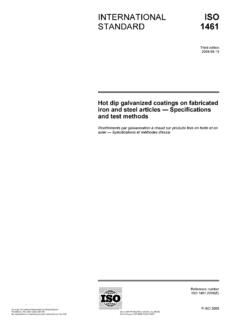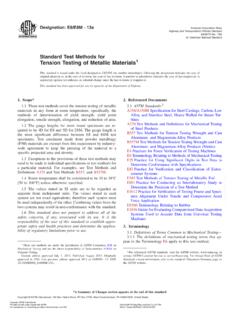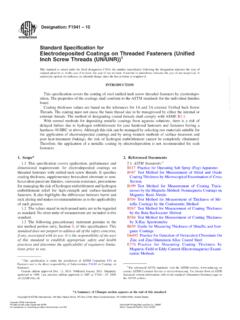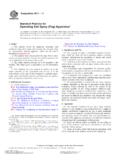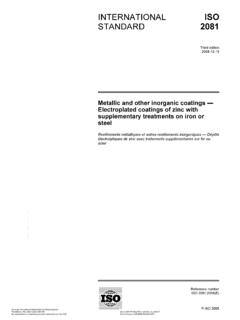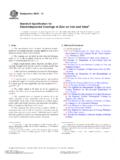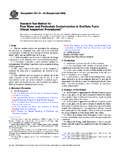Transcription of Standard Test Method for Measurement of Metal and Oxide ...
1 Designation: B487 85 (Reapproved 2013) Standard Test Method forMeasurement of Metal and Oxide coating thickness byMicroscopical Examination of Cross Section1 This Standard is issued under the fixed designation B487; the number immediately following the designation indicates the year oforiginal adoption or, in the case of revision, the year of last revision. A number in parentheses indicates the year of last reapproval. Asuperscript epsilon ( ) indicates an editorial change since the last revision or Standard has been approved for use by agencies of the Department of This test Method covers Measurement of the localthickness of Metal and Oxide coatings by the microscopicalexamination of cross sections using an optical Under good conditions, when using an opticalmicroscope, the Method is capable of giving an absolutemeasuring accuracy of m.
2 This will determine the suit-ability of the Method for measuring the thickness of Standard does not purport to address all of thesafety concerns, if any, associated with its use. It is theresponsibility of the user of this Standard to establish appro-priate safety and health practices and determine the applica-bility of regulatory limitations prior to use.(This is especiallyapplicable to the chemicals cited inTable )2. Referenced standards :2E3 Guide for Preparation of Metallographic Specimens3. Summary of Test This test Method consists of cutting out a portion of thetest specimen, mounting it, and preparing the mounted crosssection by suitable techniques of grinding, polishing, andetching.
3 The thickness of the cross section is measured with anoptical These techniques will be familiar to experienced metallogra-phers but some guidance is given in Section5and inAppendix X1for lessexperienced Significance and coating thickness is an important factor in the perfor-mance of a coating in service and is usually specified in acoating This Method is suitable for acceptance Factors Influencing the Measurement Roughness If the coating or its substrate has arough surface, one or both of the interfaces bounding thecoating cross section may be too irregular to permit accuratemeasurement. ( ) of Cross Section If the plane of the cross sectionis not perpendicular to the plane of the coating , the measuredthickness will be greater than the true thickness .
4 For example,an inclination of 10 to the perpendicular will contribute % of the coating Detrimental deformationof the coating can be caused by excessive temperature orpressure during mounting and preparation of cross sections ofsoft coatings or coatings melting at low temperatures, and alsoby excessive abrasion of brittle materials during preparation ofcross of Edge of coating If the edge of the coatingcross section is rounded, that is, if the coating cross section isnot completely flat up to its edges, the true thickness cannot beobserved microscopically. Edge rounding can be caused byimproper mounting, grinding, polishing, or etching. It isusually minimized by overplating the test specimen beforemounting.
5 ( ) Overplating of the test specimen serves toprotect the coating edges during preparation of cross sectionsand thus to prevent an erroneous Measurement . Removal ofcoating material during surface preparation for overplating cancause a low- thickness Optimum etching will produce a clearly de-fined and narrow dark line at the interface of two etching produces a poorly defined or wide linewhich may result in an erroneous test Method is under the jurisdiction of ASTM CommitteeB08on Metallicand Inorganic Coatingsand is the direct responsibility of edition approved Dec. 1, 2013. Published December 2013. Originallyapproved in 1968. Last previous edition approved in 2007 as B487 85 (2007).
6 DOI: referenced ASTM standards , visit the ASTM website, , orcontact ASTM Customer Service at ForAnnual Book of ASTMS tandardsvolume information, refer to the Standard s Document Summary page onthe ASTM ASTM International, 100 Barr Harbor Drive, PO Box C700, West Conshohocken, PA 19428-2959. United States1 Provided by IHS under license with ASTM Sold to:NW PA Reg Plann and Dev Co, 849744 Not for Resale,12/05/2014 07:40:47 MSTNo reproduction or networking permitted without license from IHS--``,,,,,```,,`,,,``,,,`,``,```,-`-`, ,`,,`,`,,` Improper polishing may leave one metalsmeared over the other Metal so as to obscure the true boundarybetween the two metals.
7 The apparent boundary may be poorlydefined or very irregular instead of straight and well verify the absence of smearing, the coating thickness shouldbe measured and the polishing, etching, and thickness mea-surement repeated. A significant change in apparent thicknessindicates that smearing was probably present during one of For any given coating thickness , mea-surement errors generally increase with decreasing magnifica-tion. If possible, the magnification should be chosen so that thefield of view is between and 3 the coating of Stage Micrometer Any error in calibra-tion of the stage micrometer will be reflected in the measure-ment of the specimen.
8 Errors of several percent are notunrealistic unless the scale has been calibrated or has beencertified by a responsible supplier. The distance between twolines of a stage micrometer used for the calibration shall beknown to within m or %, whichever is the greater. Ifa stage micrometer is not certified for accuracy, it should becalibrated. A generally satisfactory means of calibration is toassume that the stated length of the full scale is correct, tomeasure each subdivision with a filar micrometer, and tocalculate the length of each subdivision by simple of Micrometer Eyepiece A filar micrometer eyepiece generally provides themost satisfactory means of making the Measurement of thespecimen.
9 The Measurement will be no more accurate than thecalibration of the eyepiece. As calibration is operatordependent, the eyepiece shall be calibrated by the personmaking the Repeated calibrations of the micrometer eyepiececan be reasonably expected to have a spread of less than 1 %. Some image-splitting micrometer eyepieces have anonlinearity that introduces an error of up to 1 % for shortmeasurement Errors can be introduced by backlash inthe movement of the micrometer eyepiece. If the final motionduring alignment of the hairline is always made in the samedirection, this error will be of Magnification Because the magnifica-tion may not be uniform over the entire field, errors can occurif both the calibration and the Measurement are not made overthe same portion of the field with the measured boundariescentered about the optical Quality Lack of sharpness of the image contrib-utes to the uncertainty of the Measurement .
10 Poor quality lensescould preclude accurate measurements. Sometimes imagesharpness can be improved by using monochromatic of Eyepiece The movement of the hair-line of the eyepiece for alignment has to be perpendicular to theboundaries of the coating cross section. For example, 10 misalignment will contribute a % Length A change in the tube length of themicroscope causes a change in magnification and if this changeoccurs between the time of calibration and the time ofmeasurement, the Measurement will be in error. A change intube length may occur when the eyepiece is repositioned withinthe tube, when the focus of the eyepiece tube is changed, and,for some microscopes, when the fine focus is adjusted or theinterpupillary distance for binoculars is Preparation of Cross Prepare, mount, polish, and etch the specimen so The cross section is perpendicular to the coating ; The surface is flat and the entire width of the coatingimage is simultaneously in focus at the magnification used forthe Measurement .
